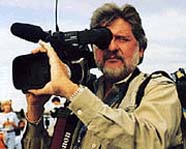(Washington, DC, August 30, 2000) In the three years that The Digital Journalist has been online, we have probably seen the greatest long-term changes in the history of photojournalism. Digital has replaced film in most newsrooms. Picture agencies have gone from being mom-and-pop operations representing their photographers, to just another holding of one mega-corporation or another. Agencies no longer know how to talk with the talent that produces what they sell. Television news has gone from being a service function of stations and networks, aimed at fulfilling a public need, to profit centers primarily, concerned with churning out the equivalent of wire service material to countless affiliates around the world. Everyone wants to compartmentalize and make a profit on the backs of photojournalists - and we're mad as hell. What on earth has happened? We think Tom Hubbard has come up with one of the most provocative answers in his article this month. He cuts through most of the static surrounding photo rights/rates, video/still, film/digital to come to this conclusion: the craftsperson/artist mentality of the photojournalist is up against the corporate/industrial mind-set. Until the late 1980s, photojournalists were viewed as anomalies within their workplace. Newspapers, magazines, and television news were in the business of journalism. Most of the people working for these institutions contributed to the production of their product as a team. On the other hand, the photographer worked alone. He or she was even able to retreat into the sanctity of the "darkroom." The definition of a photojournalist was built around rugged individualism. What they did was special and mysterious. The value of their product would vary wildly, depending upon the subject matter and quality of the picture. Editorial institutions pledged their first responsibility to the idea of a "free press." The line between "church and state," or editorial versus advertiser was never crossed. Then, beginning with the acquisition of Time Inc. by Warner Bros. (or vice versa), the order was altered. The corporation overruled editorial, while insisting nothing was going to change. But it did. Budgets for coverage started to appear costs were cut and projects were abandoned. The "special" relationships between photojournalists and the publications they worked with began to disappear. Looking back, that first acquisition seems quaint. Now, even Time Warner has been gobbled up by an entity that didn't exist when the first merger occurred - AOL. Meanwhile, the World Wide Web was creating a market that would eventually replace print. Up until recently, nobody really believed that would happen. But the facts are in. The Web will dominate publishing and television. As long as publishers and broadcasters were only worrying about what was going to appear in that day's/week's/month's edition they were happy to pay for single usage. This left photojournalists free to sell subsequent use, which made up for the fact that the publication was able to get the photographer's work on a discounted basis. Now, however, publishers realized they must be able to freely use the production of the photographer across a much broader spectrum. For them, it really isn't so much about money; it's more about the hassle involved with clearing rights for other usage. The answer was "work-for-hire." That is to say, in return for hiring a freelancer to perform an assignment, the publisher needed all rights to that work. In the past, there was a simple formula to achieve this kind of result. It was called a staff job - a fair exchange. Working for the employer meant the photographer or reporter received health insurance, a pension, along with other benefits, while the employer got the rights to the pictures. Unfortunately, in today's economy, the concept of staff photographer seems nonsensical to the employer. We have never quite figured out why the photographer, alone within the editorial team, is discriminated against when it comes to employment. Maybe it has to do with that old "darkroom thing." Last week, one of the most blatant statements made by the publishing industry regarding the copyright issue was heard at a convention in Rio de Janeiro, attended by more than 1,400 publishers and editors from 71 countries. The World Association of Newspapers, called for the end of obstacles that would prevent or hinder the development of their companies in the new digital environment. According to Media Central, their resolution stated: "Copyright law was established before this digital environment emerged. Today, this legislation has become a serious obstacle for newspaper publishers to exploit their content in a reasonable and economically viable fashion through the new distribution channels. Publishers are either prevented by law from using this content as they wish, or obliged to pay several times when this content is published in a form other than on paper." Photographers are flailing back, trying to fight this beast which takes many forms and has many identities. Award-winning photographer PF Bentley, after weeks of negotiating with Time Inc. and its covey of lawyers, on behalf of his freelance colleagues - trying for a less onerous contract - finally threw in the towel and resigned. During the past week, virtually the entire freelance photographer stable of Sygma photo agency walked out over contract terms with the new owner - Corbis. But there is a sinking feeling that whatever the merits of their case, it really doesn't matter in this new market place — this new order. The picture editors and executives of many of these companies feel as helpless as the photographers. One agency head told me, "It's a good thing all this is happening. It will force photographers to realize what is going on. Everything is changing. I think the wheel has to be reinvented, totally. They have to wake up to that fact, and maybe they will finally begin to fight. Dirck Halstead
|
|||||
